ASCOD
The ASCOD (Austrian Spanish Cooperation Development) armoured fighting vehicle family is the product of a cooperation agreement between Austrian Steyr-Daimler-Puch AG and Spanish General Dynamics Santa Bárbara Sistemas (both companies are now divisions of a unit of General Dynamics). The ASCOD family includes the LT 105, a light tank equipped with a 105 mm gun, a surface-to-air missile launcher, an anti-tank guided missile launcher, mortar carrier, R&R vehicle, command and control vehicle, ambulance, artillery observer, and the AIFV model. In Spanish service, the vehicle is called "Pizarro", while the Austrian version is called "Ulan".
| ASCOD | |
|---|---|
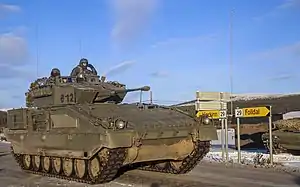 The Spanish Armed Forces Pizarro variant of the ASCOD | |
| Type | Armoured fighting vehicle (ASCOD Ulan/Pizarro) |
| Place of origin | Austria and Spain |
| Service history | |
| In service | 2002–present |
| Used by | See Operators |
| Specifications | |
| Mass | 26.3 tonnes (26,300 kg) (ASCOD Pizarro) 28 tonnes (31 short tons) (ASCOD Ulan) |
| Length | 6.83 m (22 ft) (Pizarro/Ulan), 9.5 m (31.16 ft) (ASCOD) |
| Width | 3.64 m (12 ft) |
| Height | 2.43 m (8 ft) |
| Crew | 3 + 8 passengers |
| Armor | rolled steel armor options for explosive reactive armor and composite armor |
Main armament | 30 mm Mauser MK 30/2 (ASCOD Ulan/Pizarro) |
Secondary armament | MG3 7.62×51mm NATO (Pizarro) FN MAG 7.62×51mm NATO (Ulan/ASCOD 2) |
| Engine | Diesel 600 hp (Pizarro fase 1) 720 hp (Pizarro fase 2) 720 hp (Ulan) |
| Suspension | torsion bar and Piedrafita rotary dampers models AR01 and AR02. |
| Maximum speed | Road: 72 km/h |
History
.jpg.webp)
The ASCOD was designed to replace the older light armoured fighting vehicles of the Austrian and Spanish armies, such as the M113 armored personnel carrier and the Saurer APC. The Ulan, the Austrian version of the Pizarro, would provide a flexible complement to their heavy Leopard 2A4. The Ulan would allow the Austrian army to deploy rapidly and effectively over longer distances, especially for foreseeable future operations—such as troubled spots for UN operations.[1]
In 1982, Steyr-Daimler-Puch Spezialfahrzeug initiated the conception phase for the development of a new infantry fighting vehicle. This was followed by initial talks with the militaries of Greece, Norway and Switzerland to find the desired requirements for a new IFV. The decision to develop a new IFV was made following the Bundesheer announcement of the military requirement for the Kampfschützenpanzer 90 (combat infantry fighting vehicle 90) in 1985.[2] Based on this, Steyr-Daimler-Puch Spezialfahrzeug started the conception of the vehicle; however, it was clear that Austria would not order new IFVs in the next years and that the development costs exceeded Steyr's budget.[2] Therefore, in 1988, a cooperation with the Spanish company Empresa National Santa Barbara S. A. was signed, which resulted in the development being renamed to ASCOD (Austrian Spanish Cooperative Development).[2] Following this, the development of the ASCOD was started. The hulls were manufactured in Spain, while the ASCOD turrets (based on the SP-30 turret design used on the scout version of the Pandur) were made by Steyr in Austria. The first prototype was presented in 1991 in Sevilla[2] and tested by 1992 with production being possible only four years later.[3] Initially, the design was a cooperation between Austrian Steyr-Daimler-Puch AG and the Hellenic ELVO (former Steyr Hellas) after signing the contract of domestically contracted Leonidas 2 APC ELVO Leonidas-2. The contract activated in 1988 with the obligation of the teyr-Daimler-Puch AG to follow the Hellenic Stuff instructions and the addition as many as possible parts already constructed in Greece like the wheels and caterpillar and the smoke grenades launchers based on those used on Leopard 1 tank. Also, the secondary mg MG-3 was constructed in Greece and a variant or Mauser 30F main gun. Greece withdrew from the program in 1991 after government change and Steyr-Daimler-Puch had to find a new partner. The IFV in Hellenic service would have the name Alexander the Great. Greece actually DONATED its rights on the design to Steyr-Daimler-Puch and took no money for it as a penalty of the 450 IFVs cancelled.
Following the numerous changed requirements during the ASCOD's conception and development phase, the weight increased from the original 18.8 t to 25.2 t and finally 29.0 tonnes. The first prototype was trialed in Norway in 1993/94; however, Norway decided against buying the ASCOD and preferred the Swedish CV9030 instead.[2] Following these trials, a slightly updated third prototype was built, which essentially equals the version finally offered as ASCOD to Austria, Spain and other countries. In 1994, Spain decided to order four pre-series vehicles after successful trials of the prototype. In 1996, Spain ordered 144 vehicles with the designation "Pizarro". Due to financial reasons, Austria's order for the first 112 ASCOD vehicles did not happen until May 1999. The designation "Ulan" is used for the ASCOD in Austrian service. Four pre-series Ulan were given to the Austrian Bundesheer in April 2001 for the final qualification. The official handover happened in May 2001. In 2002, 28 Ulans were delivered, the next batch of 36 was delivered in 2003 and in 2004 the order was finished.[2] In contrast to the original prototypes, the "Ulan" was completely manufactured in Austria.[2]
The ASCOD was a very modern solution to bringing both Austrian and Spanish armour up to date. To put this into perspective, the Pizarro project was a part of the greater Project CORAZA (Project Armour), which was to replace Spain's M113 APCs, M60A3s, and M110 artillery pieces.[4] By 2005, the Austrian army was equipped with 112 Ulan vehicles[1] and Spain with 144 (123 IFV and 21 C2V).[5]
In 2004, the Spanish Ministry of Defence ordered another 212 Pizarros (170 IFV, 5 C2V, 28 Artillery observation, 8 recovery, 1 Engineering vehicle) for €707.5 million Euros,[6] with up to 356 units total planned.[7] By 2010 the cost of this second batch had increased to €845m.[8]
The improved ASCOD 2 vehicle was chosen by the UK MoD in March 2010 as the common base platform for the Scout Specialist Vehicle, which was later renamed Ajax. This selection was the result of the UK's Specialist Vehicle Programme. Around 300 British engineers at General Dynamics UK's Oakdale facility began developing the Ajax from the ASCOD 2 after being awarded the contract in 2010.[9][10] The ASCOD 2 Scout SV will serve as the replacement for CVR(T) family vehicles, including the FV107 Scimitar, the FV103 Spartan and the FV106 Samson armoured recovery vehicle.
General Dynamics offered the ASCOD 2 in an APC configuration to the competition for the Danish M113 replacement. The ASCOD 2 was not chosen, as the Danish army preferred a wheeled option with the Piranha 5.[11]
Design
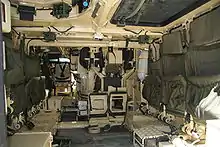
The main version of the ASCOD is the tracked infantry fighting vehicle. It follows a conventional layout with a front-mounted engine and a rear compartment for the dismounts. The driver's seat is located at the left hull front, whereas the commander and gunner sit in the slightly off-center-mounted two-man turret. The rear compartment also has two hatches on the roof. The Ulan can carry eight dismounts,[13] whereas the Pizarro only carries seven.[14]
Armament
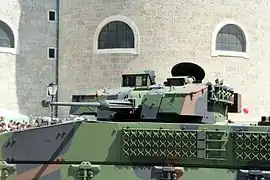
The ASCOD mounts a 30 mm Mauser MK-30/2 autocannon in a fully traversable electro-mechanical turret. The dual belt-fed 30 mm cannon, electrical stabilized on two planes, is able to fire at a rate of up to 770 rounds per minute and accurately engage targets on the move.[2] As secondary armament, the ASCOD carries a 7.62 mm machine gun; the Spanish Pizarro is fitted with an MG-3 machine gun, whereas the Ulan is fitted with an FN MAG. The Ulan carries 200 rounds of 30 mm and 600 rounds of 7.62 mm rounds in the turret, a further 205 rounds for the 30 mm gun and up to 1,290 for the 7.62 mm machine gun are stored inside the hull.[2] The Pizarro only carries 300 rounds of main gun ammunition.[14] This armament is comparable to that of the M2 Bradley and the CV90, and performed well in a Norwegian vehicles trial, although it ultimately lost to the Swedish CV90.
Optics and fire control system
The Ulan is fitted with a digital fire control system built by Kollsman,[7] which uses some components of the Kürassier A2's fire control system.[2] The gunner's sight is manufactured by Elbit and provides 8X magnification in the day channel. The integrated thermal imager has 2.8X and 8.4X magnification, which can be accessed by both the gunner and the commander. The commander has a fixed daysight with 8X magnification.[2] The Pizarro uses the Mk-10 fire control system from Indra, which has a full solution digital ballistic computer, day channel, thermal channel and laser rangefinder. Future versions of the Mk-10 will be fitted with a new VC2 thermal imager.[7]
Protection

.jpg.webp)
The ASCOD is constructed of several rolled steel armour plates. The armour provides protection against 14.5 mm armour-piercing ammunition fired from distances of 500 meters or more along the frontal 60° arc,[15] with all around protection against 7.62 mm ammunition.[7] Furthermore, the turret is fitted with two banks of 76 mm Wegmann multi-purpose grenade launchers, which can fire smoke grenades for self-protection as well as high-explosive grenades with fragmentation warhead to a maximum range of 50 metres (160 ft).[2]
The Pizarro is additionally fitted with limited amounts of SABBLIR explosive reactive armour along the frontal arc and might be upgraded with more later.[3] The SABBLIR reactive armour increases protection against shaped charge warheads as used on rocket-propelled grenades. The Ulan has been fitted with MEXAS composite armour,[17] which increases ballistic protection against up to 30 mm APFSDS rounds fired from a 1,000 m range over the forward 30° arc, and all round protection against 14.5 mm armour piercing incendiary (API) rounds from a range of 500 m.[2] The Ulan is also fitted with spall-liners in order to decrease casualties in case of armour penetration.[2]
Mobility
.jpg.webp)
In terms of mobility, the Spanish Pizarro is fitted with a 600 horsepower (450 kW) MTU SV-183 TE22 engine, while the Austrian Ulan includes a 720 horsepower (540 kW) MTU 8V-199-TE20 engine. The smaller Spanish engine gives it a power-to-weight ratio of 21, and the larger engine one of 25, offering both vehicles excellent mobility. Both versions use a Renk HSWL 106C hydro-mechanical transmission, and suspension based on torsion bar[7] and rotary dampers; designed and manufactured by "Piedrafita".[18] The ASCOD uses Diehl type 129 tracks.[19] The Pizarro can go a maximum speed of 70 km/h, and a maximum reverse speed of 35 km/h.[2][3] The ASCOD has a ground-clearance of 450 millimetres (18 in). The Ulan can accelerate from 0 to 50 kilometres per hour (31 mph) in 14 seconds. It can cross 2.3 metres (7 ft 7 in) ditches, climb 950 millimetres (37 in) walls and ford through 1.2 metres (3 ft 11 in) deep rivers. It is able to drive at 75% gradient and 40% side slope.[2]
Characteristics
Structure
| System | Country | Vendor | Notes |
|---|---|---|---|
| Hull | Spain | Santa Bárbara Sistemas | |
| Turret | Spain | Santa Bárbara Sistemas |
Sensors
| System | Country | Vendor | Notes |
|---|---|---|---|
| Fire control system | Spain | Indra Sistemas | |
| Optronic systems | Spain | Indra Sistemas |
Armament
| System | Country | Vendor | Notes |
|---|---|---|---|
| Cannon | Germany | Mauser | 30 mm MK 30/2 |
| Machine gun | Spain | Santa Bárbara Sistemas | 7.62 mm MG3 made under license from Rheinmetall |
Propulsion
| System | Country | Vendor | Notes |
|---|---|---|---|
| Suspension | Spain | Santa Bárbara Sistemas | For the Spanish version, the rotary damper system is designed and made by Piedrafita. |
| Undercarriage | Spain | Santa Bárbara Sistemas | |
| Transmission | Spain | Renk AG | For the Spanish version, a binary transmission SG 850 designed by Sapa Placencia has been incorporated. |
| Engine | Spain | Empresa Nacional Bazán | Made under license from MTU Friedrichshafen |
Variants and derivatives
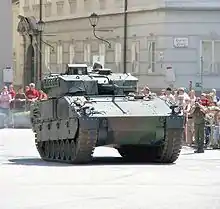

The ASCOD chassis has been used for a number of vehicles in Spanish service and numerous private ventures developed for the export market. Aside from the IFV version, the ASCOD has been offered as light tank and scout vehicle.[20][21] The ASCOD Direct Fire light tank can mount a number of different commercial turrets with 105 or 120 mm tank guns. It is expected to weigh about 30 tonnes.
Steyr-Daimler-Puch Spezialfahrzeuge has developed an improved version called Ulan 2; this, however, was never ordered by the Austrian government.[22]
An improved version of the ASCOD, called ASCOD 2, has been developed by General Dynamics and was presented in 2004. The ASCOD 2 uses the more powerful MTU 8V 199T21 engine, which provides an output of 600 kilowatts (800 hp), together with a Renk HSWL 256 B transmission and Diehl 1028 tracks.[19] It has an increased gross vehicle weight of 38 tons, with a growth potential to 42 tons. The ASCOD 2 has been presented as an IFV (with the SP-30 turret of the original ASCOD), as APC with raised roof and armed with an M2 machine gun (in a BAE Lemur remote weapon station)[23] and as specialized APC for urban combat (designated ASCOD PSO).[19]
In June 2008, GDELS, in conjunction with KMW, announced Donar, a medium-weight 155 mm self-propelled artillery system based on the KMW Artillery Gun Module (AGM) autonomous artillery system integrated with the ASCOD 2 chassis. A prototype has begun mobility and firing trials in Germany.[24][25]
In March 2010, the UK MoD announced that ASCOD 2 will be used as the base for the Scout Specialist Vehicle of the FRES program,[26] which later was renamed to "Ajax".
During Eurosatory 2018, General Dynamics European Land Systems presented a new variant of the ASCOD 2. The ASCOD medium main battle tank (MMBT), with a gross vehicle weight of 42 tonnes, is fitted with the Italian Leonardo Defence Systems HITFACT 120mm turret. This is also armed with a 7.62mm coaxial machine gun, a 7.62mm pintle-mounted gun and a 12.7mm remote weapon station on the roof. The 120mm smoothbore gun is coupled to a computerised fire control system, with the commander and gunner having stabilised day/thermal sights incorporating a laser rangefinder.[27]
- ASCOD IFV
- Driver training vehicle – ASCOD hull fitted with a fixed superstructure instead of turret.
- ASCOD Scout/Recce – ASCOD fitted with extensive ISTAR equipment and a three-man crew.[20]
- LT-105 Light Tank (ASCOD Direct Fire) – A light tank, designed for the export market, with a 105 mm or 120 mm gun. There are multiple turret options available, made by a different manufacturers: Oto Melara, Cockerill, General Dynamics, and Denel Land Systems (formerly known as LIW).[28][21]
- ASCOD 2 APC – ASCOD 2 hull with a raised roof and a remote weapon station. Offered to Denmark as an M113 replacement.[19]
- ASCOD 2 PSO – ASCOD 2 APC with improved armor protection.[19]
- Donar – Medium-weight 155 mm self-propelled howitzer based on the KMW AGM[7]

- ASCOD 2 MMBT – The name suggest it is intended as a medium main battle tank armed with either a 120mm or 105mm HITFACT turret.[27]
Ajax
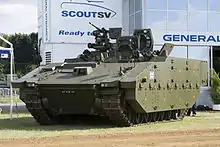
The ASCOD vehicle was chosen by the UK MoD as the common base platform on which the Ajax would be developed. This selection was the result of the UK's Specialist Vehicle Programme. Around 300 British engineers at General Dynamics UK's Oakdale facility began developing the Scout from the ASCOD after being awarded the contract in 2010.[9][10]
These vehicles are the replacements for the CVR(T) family vehicles: FV107 Scimitar (armoured reconnaissance), FV103 Spartan (specialist personnel carrier) and FV106 Samson (recovery vehicle).
Recce Block 2 is expected to include ambulance, engineer reconnaissance and command & control replacements for the CVR(T) FV104 Samaritan (armoured ambulance) and FV105 Sultan (command vehicle).
The Ajax is planned to include the following upgrades:[29]
- The main weapon will be a 40mm autocannon with "telescoped ammunition" (CT40 cannon).
- The armour will provide basic ballistic and mine protection, with upgrade add-on packages for improved protection when needed.
- The chassis will be upgraded with enhanced suspension combining torsion bars and hydraulic dampers.
- Enhanced powertrain comprising 600 kW (805 bhp) MTU V8 199 diesel engine and Renk 256B fully automatic transmission.
- The welded turret will be built by Lockheed Martin UK.
- Assembly and testing will take place in the UK [30]
The vehicle's normal combat weight is 34 tonnes.
Pizarro

ASCOD Pizarro is built by Santa Bárbara Sistemas. It has multiple variants:[3]
- VCI/C – Infantry/Cavalry Vehicle; the basic ASCOD Pizarro.
- VCPC – Command Vehicle
- VCOAV – (Vehículo de Observación Avanzada) Advanced Reconnaissance Vehicle
- VCREC – Recovery Vehicle
- VCZ Castor – (Vehículo de Combate de Zapadores) Sappers Combat Vehicle
- VCE – Combat Engineer Vehicle (under development as of December 2018)[31]
This variant is operated by Spain.
Sabrah Light Tank
The Sabrah Light Tank's tracked version is a new variant developed and offered by Elbit Systems for the Philippine Army's Light Tank Acquisition Project.[32] It uses the ASCOD 2 platform with a new turret armed with 105 mm gun developed by Elbit in partnership with Denel Land Systems.[33] The Notice of Award (NOA) for the project was issued to Elbit Systems Land by the Department of National Defense in September 2020.[34]
Ulan
ASCOD Ulan is built by Steyr-Daimler-Puch Spezialfahrzeuge. It includes a more powerful 530 kW engine, and a different fire control system built by Kollsman.[7]
In February 2023, the modernisation of the 112 IFV was announced.[35] It focuses mostly on the electronic, providing new observation equipment, a digital panel for the driver. For the rest, a renewed electrical turret drive, other revisions to the electrical system and the drivetrain.
Operators
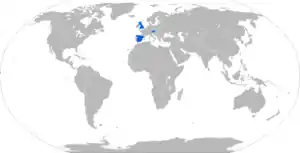
Current operators
 Austria – 112 Ulan. Delivered between 2001 and 2005.
Austria – 112 Ulan. Delivered between 2001 and 2005. Spain – 261 Pizarro. A first batch of 144 Pizarro entered service until 2003. A follow-up order of 212 vehicles, which were delivered between 2011 and 2015, was reduced to 117 following budget cuts. The current fleet is comprised as follows: 204 VCI/C, 21 VCPC and 36 VCZ Castor.
Spain – 261 Pizarro. A first batch of 144 Pizarro entered service until 2003. A follow-up order of 212 vehicles, which were delivered between 2011 and 2015, was reduced to 117 following budget cuts. The current fleet is comprised as follows: 204 VCI/C, 21 VCPC and 36 VCZ Castor. United Kingdom — 589 Ajax (Scout SV) ordered comprising: 245 Ajax, 93 Ares, 112 Athena, 50 Apollo, 38 Atlas and 51 Argus.
United Kingdom — 589 Ajax (Scout SV) ordered comprising: 245 Ajax, 93 Ares, 112 Athena, 50 Apollo, 38 Atlas and 51 Argus. Philippines – 1 demonstrator released as December, 2022, from 20 purchased.[36] Elbit Systems won the Light Tank Acquisition Project of the Philippine Army. They are supplying Sabrah Light Tank platform in different configurations: 18 tracked light tanks, 1 command vehicle and 1 recovery vehicle.[37]
Philippines – 1 demonstrator released as December, 2022, from 20 purchased.[36] Elbit Systems won the Light Tank Acquisition Project of the Philippine Army. They are supplying Sabrah Light Tank platform in different configurations: 18 tracked light tanks, 1 command vehicle and 1 recovery vehicle.[37]
Potential operators
 USA — The Griffin II light tank was selected for the US Army's Mobile Protected Firepower program. The initial contract is for 96 vehicles with first delivery by the end of 2023. The first units are expected to be equipped with it by Q4FY25. [38] General Dynamics Land Systems is offering the Griffin III IFV variant in the Optionally Manned Fighting Vehicle program to replace the M2/M3 Bradley.
USA — The Griffin II light tank was selected for the US Army's Mobile Protected Firepower program. The initial contract is for 96 vehicles with first delivery by the end of 2023. The first units are expected to be equipped with it by Q4FY25. [38] General Dynamics Land Systems is offering the Griffin III IFV variant in the Optionally Manned Fighting Vehicle program to replace the M2/M3 Bradley.
Failed bids
 Czech Republic — General Dynamics European Land Systems (GD-ELS) is offering the ASCOD to the Czech Army, which is currently selecting a replacement for the service's aging BMP-2s. GD-ELS announced on May 31 at International Defence and Security Technology Fair 2017 in Brno that it had formed partnerships with 5 Czech companies to underpin its bid.[39][40] In December 2018, ASCOD was shortlisted together with the Puma, CV90 and Lynx.[41] On 20 July 2022 the Government of the Czech Republic announced that Defence Minister Jana Černochová was authorised to begin negotiations with the Swedish Government for the procurement of CV90MkIV infantry fighting vehicles. The negotiations for the new infantry fighting vehicles will be coordinated with Slovakia who had also recently selected the CV90 MkIV.[42][43]
Czech Republic — General Dynamics European Land Systems (GD-ELS) is offering the ASCOD to the Czech Army, which is currently selecting a replacement for the service's aging BMP-2s. GD-ELS announced on May 31 at International Defence and Security Technology Fair 2017 in Brno that it had formed partnerships with 5 Czech companies to underpin its bid.[39][40] In December 2018, ASCOD was shortlisted together with the Puma, CV90 and Lynx.[41] On 20 July 2022 the Government of the Czech Republic announced that Defence Minister Jana Černochová was authorised to begin negotiations with the Swedish Government for the procurement of CV90MkIV infantry fighting vehicles. The negotiations for the new infantry fighting vehicles will be coordinated with Slovakia who had also recently selected the CV90 MkIV.[42][43]
See also
- Ajax – Family of British armoured fighting vehicles
- Griffin – Series of American armored fighting vehicles
- M2 Bradley – American infantry fighting vehicle
- CV-90 – Swedish Infantry fighting vehicle
- WPB Anders – Family of Polish medium, tracked combat vehicles
- Puma (IFV) – German infantry fighting vehicle
- Dardo IFV – Italian infantry fighting vehicle
- BVP M-80 – Yugoslavian infantry fighting vehicle
- ELVO Kentaurus – Greek infantry fighting vehicle
- Tulpar (IFV) – Turkish infantry fighting vehicle
- Bionix AFV – Singaporean infantry fighting vehicle
- K21 – South Korean infantry fighting vehicle
- Type 89 IFV – Japanese infantry fighting vehicle
- BMP-3 – Soviet designed amphibious infantry fighting vehicle
- Lynx KF31/KF41 – German armored fighting vehicle
- Warrior tracked armoured vehicle – Current British infantry fighting vehicle
- M8 Armored Gun System – American light tank
- T-15 Armata – Russian heavy infantry fighting vehicle
- List of armoured fighting vehicles by country
References
- Candil, Antonio J. "Spain's Armor Force Modernizes" in Armor, March 1, 1998. Fort Knox, KY: US Army Armor Center. ISSN 0004-2420.
- "Quo Vadis Armour?" in Military Technology, November 1, 2003.
- Army Technology
- Spain's Ministry of Defence
- ¿INFANTERÍA MECANIZADA?
- Quod Vadis Armour?
- Kosar, Dipl.-Ing. Franz. ""Ulan" - Der neue Schützenpanzer des Österreichischen Bundesheeres". bundesheer.at. Truppendienst magazine. Retrieved 17 September 2015.
- "Santa Bárbara Sistemas website on ASCOD". Archived from the original on 2011-07-11. Retrieved 2010-03-26.
- Candil, p. 42
- Principales Programas de Armamento de DGAM
- Ministry of Defence
- Army Technology website on ASCOD
- Ministerio de Defensa (September 2011). "Evaluación de los Programas Especiales de Armamento (PEAs)" (PDF) (in Spanish). Madrid: Grupo Atenea. Archived from the original (PDF) on 24 October 2013. Retrieved 30 September 2012.
- "Britain to buy GD UK Vehicles", Defense News, archived from the original on January 21, 2013
- General Dynamics UK team awarded contract to deliver Specialist Vehicle for British Army, UK, archived from the original on 2010-03-25, retrieved 2010-03-26
- de Larrinaga, Nicholas. "Denmark selects Piranha V, halts artillery buy". janes.com. Jane's IHS. Retrieved 20 September 2015.
- "Janes | Latest defence and security news".
- "Schützenpanzer "Ulan"". bundesheer.at. bundesheer.at (Austrian army). Retrieved 17 September 2015.
- "MATERIALES - Armamento Pesado Vehículo Combate". ejercito.mde.es/. Spanish Army.
- "Der Schützenpanzer Ulan". doppeladler.com. Retrieved 17 September 2015.
- "References". rheinmetall-chempro.com. Rheinmetall Chempro. Retrieved 17 September 2015.
- [sti] STI soluciones www.stisoluciones.com. "Rotary dampers (Shock absorbers) / Rugged Testing / Engineering services". Piedrafita. Retrieved 2022-04-15.
- "Superior performance in any environment - ASCOD" (PDF). General Dynamics European Land Systems (gdels.com). General Dynamics European Land Systems. Archived from the original (PDF) on 15 June 2015. Retrieved 20 September 2015.
- "ASCOD / SCOUT/RECCE" (PDF). gdels.com. General Dynamics European Land Systems. Archived from the original (PDF) on 2015-07-21. Retrieved 2015-09-22.
- "ASCOD / DF" (PDF). gdels.com. General Dynamics European Land Systems. Archived from the original (PDF) on 10 March 2016. Retrieved 20 September 2015.
- Military Today website on the Ulan
- Foss, Christopher F. "Eurosatory 2014: GDELS-SBS displays latest ASCOD 2". janes.com. Jane's IHS. Retrieved 20 September 2015.
- "General Dynamics European Land Systems Press Release" (PDF). Archived from the original (PDF) on 2011-07-11. Retrieved 2010-03-28.
- "DONAR - The revolution of artillery". kmweg.de. Krauss-Maffei Wegmann. Retrieved 22 September 2015.
- "THE HOUSEHOLD CAVALRY & ROYAL ARMOURED CORPS - Future Rapid Effect System Specialist Vehicles (FRES SV)". armedforces.co.uk. armedforces.co.uk. Retrieved 22 September 2015.
- "Janes | Latest defence and security news".
- LMT 105, ZA: Denel Land Systems
- ASCOD 2 data, Army Recognition
- "Janes | Latest defence and security news".
- Foss, Christopher F. (17 December 2018). "Spain's Pizarro combat engineer vehicle takes shape". IHS Jane's 360. London. Archived from the original on 18 December 2018. Retrieved 18 December 2018.
- "Sabrah Light Tank, Israel". Army Technology. 28 February 2022. Archived from the original on 24 June 2022. Retrieved 9 July 2023.
- "Detailing Elbit's Sabrah Light Tank Offer". Pitz Defense Analysis. 17 July 2022. Retrieved 9 July 2023.
- "Light Tank Acquisition Project of the Philippine Army". Philippine Defense Resource. Retrieved June 24, 2019.
- "Austria releases 561 million to modernize its SPz Ulan infantry fighting vehicle | Defense News July 2023 Global Security army industry | Defense Security global news industry army year 2023 | Archive News year". www.armyrecognition.com. Retrieved 2023-07-07.
- "Filipinas exhibe el primer Sabrah, el tanque ligero basado en el Castor español".
- "Philippines awards contract for light tanks and wheeled APCs to Elbit Systems of Israel". Army Recognition. Archived from the original on 9 July 2023. Retrieved October 26, 2020.
- "General Dynamics wins $1.14 billion Mobile Protected Firepower contract". Breaking Defense. 28 June 2022. Retrieved June 28, 2022.
- Anderson, Guy (1 June 2017). "GD forms Czech partnerships to meet IFV requirement". IHS Jane's 360. Archived from the original on 2 June 2017. Retrieved 2 June 2017.
- "General Dynamics European Land Systems - IDET". BVV Trade Fairs Brno. Brno. Archived from the original on 2 June 2017. Retrieved 2 June 2017.
- "Czech Republic; Four firms shortlisted in BVP armoured vehicle tender". Defense Market Intelligence. 19 December 2018. Archived from the original on 19 December 2018. Retrieved 19 December 2018.
- "Defence Minister authorised to negotiate procurement of CV90 vehicles, F-35 fighters | Ministry of Defence & Armed Forces of the Czech Republic". www.army.cz. Retrieved 2022-07-20.
- "Czech IFV replacement contract delayed another year". Janes.com. Retrieved 2022-07-20.